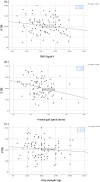Sarcopenia Seems to Be Common in Older Patients With Restless Legs Syndrome
- PMID: 39568327
- PMCID: PMC11670161
- DOI: 10.1002/jcsm.13637
Sarcopenia Seems to Be Common in Older Patients With Restless Legs Syndrome
Abstract
Background: Restless legs syndrome (RLS) is a disorder characterized by nocturnally exacerbating pain that leads to significant sleep disturbances. The hormonal and metabolic changes caused by sleep disruption may increase the incidence of muscle-related diseases like sarcopenia in older adults, which is defined by a progressive loss of muscle strength and mass. This study aimed to investigate the relationship between RLS and sarcopenia, which may affect each other through common pathophysiological pathways in older adults.
Methods: This was a cross-sectional study including 109 patients with RLS and 220 without RLS who applied to the geriatric clinic. RLS was assessed using the Turkish version of the International Restless Legs Syndrome Study Group (IRLSSG). Sarcopenia was diagnosed according to the European Working Group on Sarcopenia in Older People-2 criteria. All the demographics, comorbid conditions, medications and findings of comprehensive geriatric assessments were recorded. The association between RLS and sarcopenia was examined by logistic regression.
Results: The mean age was 75 ± 7.4 and 73.8 ± 7 years for the RLS and the control groups, respectively (p > 0.05) and the ratio of females was higher in the RLS group (69.7% vs. 57.9%) (p = 0.035). The frequencies of coronary artery disease (CAD), hypertension (HT) and peripheral artery disease (PAD) were significantly higher in RLS patients (p = 0.020, p = 0.047, p = 0.010, respectively), while the prevalence of anaemia was 41% and 25-OH Vitamin D levels (25[OH]D) were higher than in the control group (p < 0.001). The frequency of probable sarcopenia and sarcopenia was higher in patients with RLS than in controls (20% vs. 11%, p = 0.037 and 8% vs. 2.3%, p = 0.047, respectively). A significant association between RLS and an increased likelihood of probable sarcopenia, sarcopenia and slow gait speed (odds ratio [OR]: 2.621, 95% confidence interval [CI] [1.265, 5.431]; OR: 4.542, 95% CI [1.284, 16.071]; OR: 2.663, 95% CI [1.432, 4.951], respectively) was found after adjusting for factors such as gender, HT, CAD, PAD, serum 25(OH)D levels, anaemia, chronic kidney disease (CKD) and nutritional status. However, the significance of low muscle mass disappeared (p > 0.05).
Conclusion: This study demonstrated that sarcopenia is prevalent among older patients with RLS, which seems to be associated with low muscle strength and slow gait speed. Given the negative health outcomes related to sarcopenia, interventions aimed at preventing its development could be significantly beneficial for patients with RLS in older adults as well.
Keywords: low muscle strength; restless legs syndrome; sarcopenia; slow gait speed.
© 2024 The Author(s). Journal of Cachexia, Sarcopenia and Muscle published by Wiley Periodicals LLC.
Conflict of interest statement
The authors declare no conflicts of interest.
Figures


References
-
- Manconi M., Garcia‐Borreguero D., Schormair B., et al., “Restless Legs Syndrome,” Nature Reviews Disease Primers 7 (2021): 80. - PubMed
-
- Celle S., Roche F., Kerleroux J., et al., “Prevelance and Clinical Correlates of Restless Legs Syndrome in an Elderly French Population: The Synapse Study,” Journals of Gerontology. Series a, Biological Sciences and Medical Sciences 65 (2010): 167–173. - PubMed
-
- Larsson B. W., Kadi F., Ulfberg J., and Aulin K. P., “Skeletal Muscle Morphology in Patients With Restless Legs Syndrome,” European Neurology 58 (2007): 133–137. - PubMed
-
- Salminen A. V., Rimpila V., and Polo O., “Peripheral Hypoxia in Restless Legs Syndrome (Willis‐Ekbom Disease),” Neurology 82 (2014): 1856–1861. - PubMed
-
- Monico‐Neto M., Antunes H. K. M., Dattilo M., et al., “Resistance Exercise: A Non‐Pharmacological Strategy to Minimize or Reverse Sleep Deprivation‐Induced Muscle Atrophy,” Medical Hypotheses 80 (2013): 701–705. - PubMed
MeSH terms
Grants and funding
LinkOut - more resources
Full Text Sources
Medical
Miscellaneous

